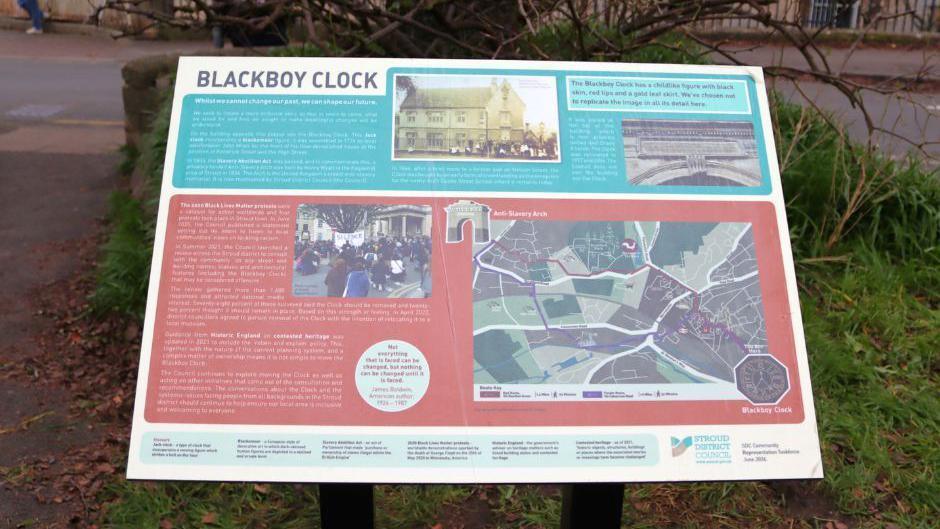Walking routes link together abolition landmarks

The Anti-Slavery Arch in Paganhill is the UK's oldest anti-slavery memorial
- Published
Two landmarks linked to the slave trade and its abolition have been joined together by new walking routes designed to give them some context.
An information plaque outlining the history of the Blackboy Clock and statue has been installed outside Blackboy House in Stroud, Gloucestershire.
It shows two paths leading to the Anti-Slavery Arch in Paganhill, which was built in 1834 to commemorate the abolition of slavery in the British Empire in 1833.
Officials said the information board "provides important context" surrounding abolition in the United Kingdom, and promoted "ongoing conversations" around slavery.

The information board aims to provides context around the landmarks and shows a map linking them together by two walking routes
The Grade II* Anti-Slavery Arch in Paganhill is the UK's oldest anti-slavery memorial.
It was built in 1834 as the grand entrance to a Georgian mansion by Henry Wyatt, a wealthy local businessman associated with the Stroud Anti-Slavery Society.
It is now owned by Stroud District Council, which has commissioned £42,000 worth of stone repairs and cleaning, which is expected to be completed next month.

The statue features on the side of a privately owned Grade II listed building
The Blackboy Clock was created by clock and watchmaker John Miles in 1774.
A report into the clock found that it was likely to be one of only 20 surviving examples of its kind in Britain.
It could not verify whether the accompanying statue was a depiction of a slave, however it stated: "Whatever the inspiration or its origins, it has to be remembered that, without a doubt, the boy's image came directly or indirectly through the influence of slavery and colonialism".
There have been campaigns to remove the clock and statue, described as an "offensive racist relic", but as they were privately owned the council cannot intervene.
However, the new information board provided the vital context behind the landmarks to ensure the history of the slave trade was never forgotten.
'Ongoing conversation'
The plaque has been developed by the Community Representation Taskforce, a group brought together in 2023.
The community project aimed to celebrate Stroud district as a welcoming and inclusive place to live, work and visit.
Taskforce member Dan Guthrie said: "Myself and my fellow Taskforce members hope that this plaque provides a greater context for the history of the Blackboy Clock at street level where previously there was no information available.
"The plaque going up is a step forward in what we feel is the right direction for what should happen with this item of public statuary in our district, but is certainly not the end of what continues to be an ongoing conversation."
Follow BBC Gloucestershire on Facebook, external, X, external and Instagram, external. Send your story ideas to us on email or via WhatsApp on 0800 313 4630.
Related topics
- Published21 April 2022

- Published24 January 2022

- Published27 January 2022
